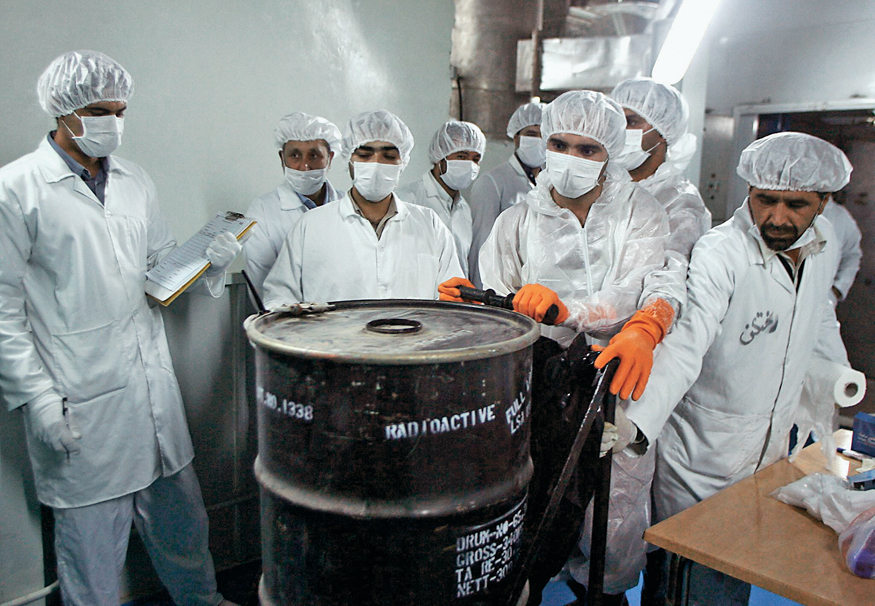A History of World Societies:
Printed Page 1031
A History of World Societies Value
Edition: Printed Page 1046
An Expanding Atomic Age
After the bombing of Hiroshima and Nagasaki in 1945 (see “The War in the Pacific, 1942–1945” in Chapter 30), the United States briefly held a monopoly on atomic weapons. Since then, a growing number of nations have developed nuclear arms, which they use as a deterrent against attack and as a means to increase their international leverage and prestige.
The Cold War arms race resulted in intense competition for the development of increasingly powerful atomic weapons, and it also meant massive spending in the United States, the Soviet Union, and Europe on the development of other weapons, ranging from ballistic missile systems to jets, tanks, and all manner of other weapons. While the superpowers and their closest allies sought to restrict access to nuclear weapons, they sold huge numbers of conventional arms to other nations. (See “Global Trade: Arms.”)
Amid the Cold War arms race, atomic tests brought fear that radiation would enter the food chain and cause leukemia, bone cancer, and genetic damage. Concerned scientists called for a ban on atomic bomb testing. In 1963 the United States, Great Britain, and the Soviet Union reached an agreement, eventually joined by more than 150 countries, to ban nuclear tests in the atmosphere. In 1970 more than sixty countries signed the Treaty on the Non-
This outcome did not come to pass. French and Chinese leaders disregarded the test ban and by 1968 had developed their own nuclear weapons, although they later signed the nonproliferation treaty. India also developed nuclear weapons and in 1974 exploded an atomic device. Meanwhile, the nuclear arms race between the Soviet Union and the United States was so intense that after the 1960s both sides sought ways of slowing it and negotiated shared limits to their nuclear arsenals. The Strategic Arms Limitation Talks (SALT), which took place between 1969 and 1979, limited the rate at which the two superpowers produced nuclear warheads, and in 1991 the United States and Russia negotiated the first Strategic Arms Reduction Treaty (START I), which eventually removed about 80 percent of existing strategic nuclear weapons. The New START treaty, signed by U.S. president Barack Obama and Russian president Dmitry Medvedev in 2010, required the two countries to further reduce the number of their nuclear warheads by one-
India developed its atomic capability partly out of fear of China, but India’s nuclear test in 1974 in turn frightened Pakistan, which pursued its own nuclear weapons. In 1998 both India and Pakistan tested nuclear devices within weeks of each other, confirming their status as the world’s sixth and seventh acknowledged nuclear powers, after the United States, Russia, the United Kingdom, France, and China. Other nations discreetly pursued nuclear arms without publicly stating that they possessed them.
In the 1950s Israel began developing nuclear weapons, and it is generally believed to have had an arsenal of nuclear weapons since the 1970s, though Israel has never publicly confirmed this. Israel’s apparent nuclear superiority was threatening to Arab states that for decades had tried to vanquish Israel. When Iraq attempted, with help from France, to develop nuclear capability in the 1980s, Israel responded by attacking and destroying the Iraqi nuclear reactor in June 1981.
The risks associated with the proliferation of nuclear weapons helped mobilize the international community and contributed to positive developments through the 1980s and 1990s. Between 1983 and 2003 Argentina, Romania, Brazil, South Africa, and Libya all agreed to abandon their nuclear weapons programs. Several of the former Soviet republics that possessed nuclear arsenals, including Ukraine, Belarus, and Kazakhstan, returned their nuclear weapons to Russia. International agencies monitored exports of nuclear material, technology, and missiles that could carry atomic bombs. These measures encouraged confidence in global cooperation and in the nonproliferation treaty, which was extended indefinitely in 1995. The treaty has been signed by 190 countries as of 2014.
Despite these efforts, nuclear proliferation has continued. In 2003 the United States accused Iran of seeking to build nuclear weapons, and ongoing diplomatic efforts, sanctions, and other punitive measures by France, Germany, Britain, China, the United States, and Russia have failed to induce Iran to limit its nuclear program. There is also the threat that enriched nuclear materials will fall into the hands of terrorist organizations or that countries possessing nuclear weapons technology would share it with other nations. In 2004 the father of Pakistan’s nuclear weapons program, Abdul Qadeer Khan, was charged by a Pakistani military court with sharing nuclear weapons expertise and technology with Iran, Libya, and North Korea.

In the new century long-
For nations still pursuing the development of nuclear weapons, and for some of the nations that recently developed them, nuclear diplomacy has played a primary role in shaping their relations with the world.